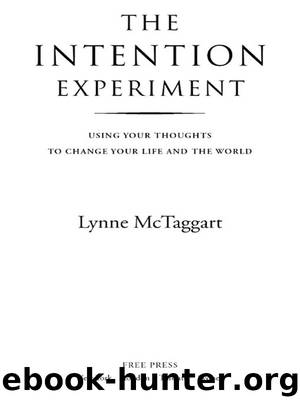The Intention Experiment by Lynne McTaggart

Author:Lynne McTaggart
Language: eng
Format: epub
Publisher: Atria Books
Published: 2007-12-03T05:00:00+00:00
Chapter 10
The Voodoo Effect
Dick Blasband was drawn to the idea that there might be a way to amplify and direct life energy, like holding up a magnifying glass to focus the rays of the sun. Blasband, a psychologist, was intrigued by the theories of Wilhelm Reich, the Austrian psychiatrist and one-time protégé of Sigmund Freud, who thought it possible to trap “orgone”—the name he gave to what he believed to be omnipresent cosmic energy—in an orgone energy “accumulator.” An accumulator, a boxlike enclosure of any size, could be made of alternating layers of any metal and nonmetallic materials, such as cotton cloth or felt. Reich believed that atmospheric energy would be first attracted, then instantly repelled by the metal and eventually absorbed by the nonmetallic substance. Because the enclosure was layered, orgone energy would continuously flow between the atmosphere and the box, like a current of air, and so constantly “accumulate.” Reich had early encouraging results with animals and plants placed in the boxes, which laid the basis for his later claims that accumulated energy had an immense capacity to heal.
It occurred to Blasband that Reich’s ideas about energy fields were not dissimilar to those of his colleague Fritz-Albert Popp and Popp’s work on biophotons. Perhaps the best means of testing an accumulator was to measure its effect on the emission of these tiny specks of light from a living thing.
In August 1993, Blasband traveled to Popp’s International Institute in Kaiserslautern, Germany. He and Popp created a variety of orgone accumulators, then chose a number of plants in Popp’s laboratory—cress seeds; cress seedlings; and Acetabularia crenulata, a primitive form of marine algae—to be the experimental population. Popp’s photomultipliers would count the light emissions of all the plants inside and outside the orgone boxes and record any differences.
Blasband carried out four experiments, placing the algae in the accumulator—first for one hour, and then continuously for two weeks—with no result. Popp’s equipment recorded not the slightest alteration in the light emissions. Blasband wondered if this was because the plants were already so healthy that the boxes could not improve their state of health. Perhaps he would see a larger change in a subject that needed help or improvement. He and Popp decided to try making the Acetabularia “ill” by depriving it of most of its vitamin supply for 24 hours before treatment. This appeared to make no difference. The plants’ biophotons didn’t change. No amount of exposure to an accumulator of any variety seemed to make one bit of difference to the health or well-being of any of the plants.
Blasband and Popp then decided to test whether a mental intention could boost the action of the accumulators. In his new series of experiments, Blasband sent an intention for the energy within the accumulator to be beneficial to certain seedlings and harmful to others. These results were disappointing, too. There was only one significant difference in the number or quality of biophoton emissions before and after treatment of any of the plants: the only effective intention appeared to be the one he had sent to stunt their growth.
Download
This site does not store any files on its server. We only index and link to content provided by other sites. Please contact the content providers to delete copyright contents if any and email us, we'll remove relevant links or contents immediately.
Tools of Titans by Timothy Ferriss(7797)
Crystal Healing for Women by Mariah K. Lyons(7706)
The Witchcraft of Salem Village by Shirley Jackson(7029)
Inner Engineering: A Yogi's Guide to Joy by Sadhguru(6432)
The Four Agreements by Don Miguel Ruiz(6305)
The Power of Now: A Guide to Spiritual Enlightenment by Eckhart Tolle(5325)
Secrets of Antigravity Propulsion: Tesla, UFOs, and Classified Aerospace Technology by Ph.D. Paul A. Laviolette(4972)
The Wisdom of Sundays by Oprah Winfrey(4946)
Room 212 by Kate Stewart(4729)
Pale Blue Dot by Carl Sagan(4610)
Fear by Osho(4488)
The David Icke Guide to the Global Conspiracy (and how to end it) by David Icke(4375)
Rising Strong by Brene Brown(4190)
Animal Frequency by Melissa Alvarez(4147)
How to Change Your Mind by Michael Pollan(4111)
Sigil Witchery by Laura Tempest Zakroff(4025)
Real Magic by Dean Radin PhD(3917)
Man and His Symbols by Carl Gustav Jung(3841)
The Art of Happiness by The Dalai Lama(3841)
